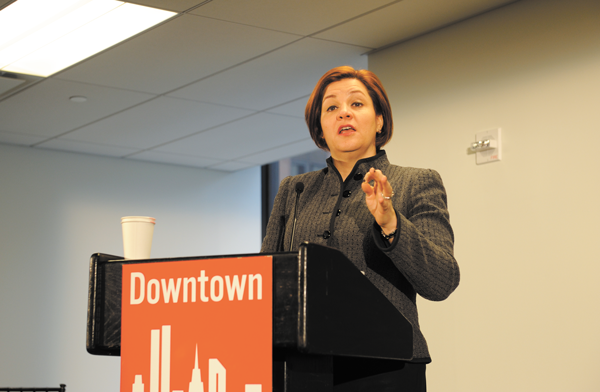
Downtown Express photo by Terese LoEb Kreuzer
BY TERESE LOEB KREUZER | At a Real Estate Board of New York forum on Feb. 28 mayoral candidate and City Council Speaker Christine Quinn left no doubt about her priorities.
“Responding to Hurricane Sandy in a comprehensive way is the largest infrastructure challenge of our time, in my opinion,” she said. “It’s about barriers. It’s about materials, how we build, where we build, the building codes, the flood maps.”
She also mentioned the need to reevaluate telecommunications and energy systems and gasoline availability, all of which suffered when Sandy came calling on Oct. 29, 2012.
Quinn asserted that the city can’t wait a year or two to deal with these issues. “We need to seize the urgency of this moment so that we move forward comprehensively,” she said.
The forum, co-sponsored by the Downtown Alliance, which administers a business improvement district in Lower Manhattan, focused on the Lower Manhattan real estate picture. The building in which the forum was held, 100 Water St., was among the large office buildings in the area that had their electrical and communication systems destroyed by flooding and had to close for many months.
According to information presented at the forum, 99 percent of these buildings have now reopened.
But, said Quinn, “this is a citywide conversation because what we do to protect Lower Manhattan will create more resources in the next storm that don’t have to be here — that can be somewhere else.”
She said it was time “to move beyond the endless academic discussions about hardening the exterior of New York City” and make a commitment to creating “a comprehensive network of barriers.”
Unlike Mayor Michael Bloomberg, who has been skeptical about the efficacy of storm surge barriers, Quinn believes that they should be studied with urgency by the Army Corps of Engineers and if found feasible, deployed along with a network of natural barriers such as large sand dunes, oyster beds, reefs and a bluebelt like the one that has been created in Staten Island. A bluebelt preserves natural drainage corridors including streams, ponds and wetlands, allowing them to convey, store and filter storm water.
Quinn commended New York Governor Andrew Cuomo for his expressed willingness to buy up properties on Staten Island that will help to expand the bluebelt that protects Staten Island significantly.
She also commended U.S. Senator Charles Schumer for pushing the Army Corps of Engineers to embark on a study of manmade sea walls to help protect New York City.
Quinn said that immediately after Sandy struck New York City, she and Mayor Bloomberg reconvened the Building Resiliency Task Force — a group of experts in real estate, climate change, environment and building who had previously worked with the city to come up with recommendations about building codes and flood zones.
At the end of six months, the task force is supposed to deliver a comprehensive report, but has also been charged with delivering rolling recommendations so that, in Quinn’s words, “we know what we have to change about the building code, we know what we have to change about what we build, how we build and where we build.”
Nothing could be 100 percent effective, Quinn acknowledged, but these measures taken together should place New York City in the strongest possible position to prevent future storm-related disasters.
Some of the other candidates vying for the Democratic mayoral nomination have been less enthusiastic than Quinn about broad-brush protection for New York City.
Former City Comptroller William C. Thompson, Jr., believes that the money isn’t there — and won’t be there — to implement ambitious proposals, any one of which could cost billions.
Bill de Blasio has said that many of the proposals are disproportionately weighted toward protecting Manhattan, leaving the other boroughs exposed.
But in Manhattan Borough President Scott Stringer, who is running for City Comptroller, Quinn has an ally. In his final State of the Borough speech on Thursday, Feb. 7, he proposed an East River Blueway between the Brooklyn Bridge and 38th St. with wetlands and a newly constructed pedestrian bridge that could help to serve as a flood barrier.
Even before Sandy, he had advocated for a study by the Army Corps of Engineers on the feasibility of storm surge barriers to protect Manhattan.
Despite skeptics, Quinn was upbeat that New York City would recover fully. “When we fully turn the corner, we will be an example to cities all across America,” she said.

















